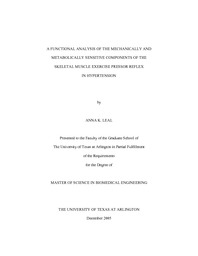
ATTENTION: The works hosted here are being migrated to a new repository that will consolidate resources, improve discoverability, and better show UTA's research impact on the global community. We will update authors as the migration progresses. Please see MavMatrix for more information.
Show simple item record
| dc.contributor.author | Leal, Anna Katherine | en_US |
| dc.date.accessioned | 2007-08-23T01:56:03Z | |
| dc.date.available | 2007-08-23T01:56:03Z | |
| dc.date.issued | 2007-08-23T01:56:03Z | |
| dc.date.submitted | November 2005 | en_US |
| dc.identifier.other | DISS-1132 | en_US |
| dc.identifier.uri | http://hdl.handle.net/10106/98 | |
| dc.description.abstract | Background - In hypertension, physical activity creates a risk for adverse cardiac events by causing exaggerated increases in mean arterial pressure (MAP) and heart rate (HR). One physiological mechanism responsible for this cardiovascular hyperactivity is the exercise pressor reflex (EPR). The EPR is a neural pathway originating in skeletal muscle that contributes to cardiovascular regulation during exercise. The EPR is composed of two afferent arms: one is comprised of mostly mechanically sensitive, group III afferent fibers that respond to muscle stretch and pressure, and the other is predominantly metabolically sensitive, group IV afferent fibers that respond to the chemical milieu surrounding working muscle. Knowing that the EPR is overactive in hypertension, it is hypothesized that both the mechanically sensitive and metabolically sensitive components of the EPR are overactive and help drive the exaggerated cardiovascular response to exercise in hypertension. Methods and Results - To test this hypothesis, an experimental protocol was developed to test the two pathways separately in male normotensive Wistar-Kyoto (WKY) and in male Spontaneously Hypertensive (SHR) rats. The mechanically sensitive component of the EPR was activated by passively stretching the triceps surae muscle. At maximal tension, the increases in MAP and HR were significantly greater in SHR (MAP = 28 ± 5 mmHg; HR = 8 ± 2 bpm) compared to WKY (MAP = 13 ± 2 mmHg; HR = 5 ± 1 bpm) animals. In addition, the cardiovascular response to passive stretch over a range of submaximal intensities was larger in the SHR than in the WKY group. The metabolically sensitive component of the EPR was activated by administering the pungent chemical capsaicin into the rats' hindlimb arterial supply. Capsaicin is known to selectively stimulate the group IV afferent fibers. The cardiovascular responses were greater in SHR animals than in WKY animals. Specifically, the increases in MAP evoked by the capsaicin doses of 0.3 and 1.0 µg/100 µL were significantly larger for SHR (47 ± 7 mmHg and 70 ± 7 mmHg, respectively) rats than for WKY (29 ± 3 mmHg and 43 ± 9 mmHg, respectively) rats. Conclusions - The abnormal cardiovascular response to exercise that occurs in hypertension is mediated, in part, by the overactivity of the mechanically and metabolically sensitive components of the exercise pressor reflex. Knowledge about the mechanoreflex and metaboreflex dysfunction in hypertension could lead to therapeutic interventions that would increase exercise tolerance and allow hypertensive individuals to reap the benefits of physical activity without risk for the generation of adverse cardiovascular events. | en_US |
| dc.description.sponsorship | Smith, Scott | en_US |
| dc.language.iso | EN | en_US |
| dc.publisher | Biomedical Engineering | en_US |
| dc.title | A Functional Analysis Of The Mechanically And Metabolically Sensitive Components Of The Skeletal Muscle Exercise Pressor Reflex In Hypertension | en_US |
| dc.type | M.S. | en_US |
| dc.contributor.committeeChair | Smith, Scott | en_US |
| dc.degree.department | Biomedical Engineering | en_US |
| dc.degree.discipline | Biomedical Engineering | en_US |
| dc.degree.grantor | University of Texas at Arlington | en_US |
| dc.degree.level | masters | en_US |
| dc.degree.name | M.S. | en_US |
Files in this item
- Name:
- umi-uta-1132.pdf
- Size:
- 1.353Mb
- Format:
- PDF
This item appears in the following Collection(s)
Show simple item record


